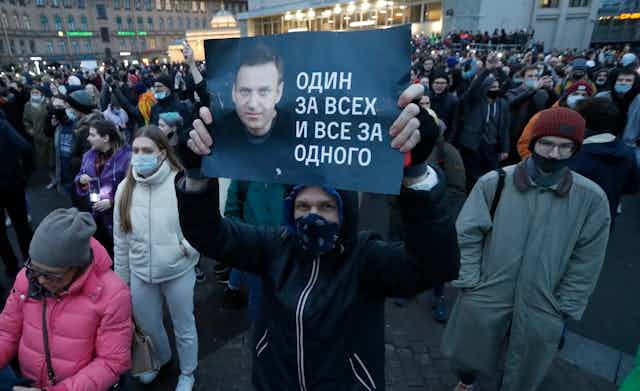Tens of thousands of protesters gathered in the streets of Russia’s cities on April 21 to support the imprisoned dissident politician Alexei Navalny. At the time, Navalny was on a hunger strike that he has now ended, saying his demands regarding medical treatment were partially met.
Protest numbers were down compared to those seen following his arrest and trial after returning to Russia in January. This fall reflected the ferocity of the Putin administration’s crackdown against his movement. A number of Navalny’s aides were arrested before the demonstrations could get underway.
The anti-corruption activist returned to Russia in January 2021 following treatment in Germany after being poisoned in August 2020. A joint investigation led by the investigative website Bellingcat presented evidence that the Russian Federal Security Service (FSB) tried to kill him with Novichok – a weapons-grade nerve agent.
On landing in Moscow in January, Navalny was immediately detained – and later jailed for violating the terms of a suspended sentence originally handed down in 2014 – an embezzlement case that the European Court of Human Rights ruled in 2017 was “arbitrary and manifestly unreasonable”.
Navalny was sent to a prison colony described as “one of Russia’s toughest”. His health rapidly deteriorated. In response to the prison authority’s refusal to grant his legal right to see a doctor of his choosing, Navalny announced on March 31 he would go on hunger strike – a move that saw his health deteriorate further.
Thorn in Putin’s side
Navalny is a long-time critic of Russian president, Vladimir Putin. His explicit anti-corruption activism goes back at least a decade and a half. At 44, his political leadership and protest organising have made him the most prominent figure in the anti-Kremlin opposition, as we discuss in our forthcoming book, Navalny: Putin’s Nemesis, Russia’s Future?.
Despite being barred from running in the 2018 presidential elections, Navalny still presents a political threat. His network of offices across the country is planning tactical voting to take on the authorities in national parliamentary elections in September. This “smart voting” project brought some success in previous elections – and could prove even more effective this year, given the relatively low support for the Kremlin-backed political party, United Russia.
Read more: Russia: Alexei Navalny's return adds to an already challenging year for Vladimir Putin
Navalny’s own approval rating is only around 20% – but this partly reflects the constant vilification he receives at the hands of the state media, which insists he is a “CIA stooge”. His significance, however, can’t be reduced to his approval level – he provides a vivid example of an alternative, critical stance in a system that actively excludes such voices.
Ratcheting up repression
The April 21 protests were the fourth time Russians had come out on to the streets since Navalny’s return. The first protest on January 23 – days after his arrest at Moscow’s Sheremetyevo airport – brought 160,000 people out across 114 cities. About 40% of those people said they were taking part in an anti-government protest for the first time.
The Kremlin was motivated to make it their last. Awesome displays of police power, mass detentions and criminal cases launched against protesters showed the willingness of authorities to punish dissent. And it worked. Analysis shows that the places with the most detentions of participants on January 23 saw the greatest reductions in protesters on January 31, when the overall protest number has been estimated at 66,000. Turnout on February 2 in response to Navalny’s prison sentence was lower still.

The state has also cracked down on Navalny’s movement more broadly. The government is thought likely to label Navalny’s organisations “extremist” – a dramatic move that will make it all but impossible for his team and supporters to operate as normal in Russia. Under Russian law, leaders of “extremist organisations” can be imprisoned for up to ten years. Members face up to six years.
In the past few weeks, Navalny’s supporters launched a website that aimed at registering 500,000 people ready to protest, before setting a date for the mass demonstration. But as Navalny’s health deteriorated, his team did not wait for the number of registrations to reach that target. About 466,000 had registered by April 21.

With no full turnout figures available for the latest rallies, the first rough estimates from individual cities suggest that numbers were smaller than in January. At the time of writing, 1,800 arrests have been reported. On the whole, the police response appeared to be more measured, especially in Moscow, where Putin was delivering a “state-of-the-nation” speech the same day.
In the short term, the state’s plan to demoralise and deter protesters seems to be working. But, by removing Navalny and weakening his movement, the Kremlin isn’t tackling the underlying reasons why people support him in the first place. Putin’s speech addressed one such reason, promising new social spending. The Russian president said that “the state must provide direct support to families with children who find themselves in a difficult situation”.
This will likely be far from enough to end the simmering discontent in Russian society. And that might mean that, although protest has been suppressed for now, tension will continue to build under the surface – a particular worry for the Kremlin, ahead of September’s elections.

